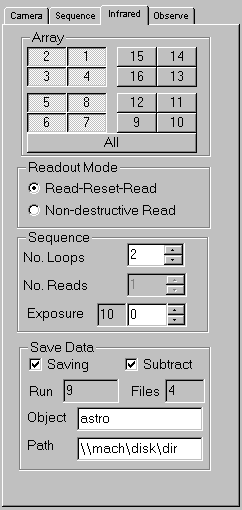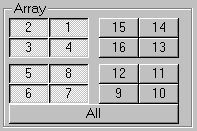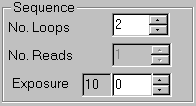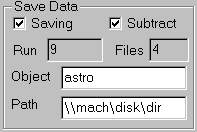
The infrared control panel contains most of the extra functions needed to operate the infrared arrays in a variety of readout modes.
The controls are split into four main areas,


This display reflects the arrangement of the detectors in the
instrument. Each detector is made up of four independent quadrants,
this control allows any pattern of quadrants to be read. The above
example shows all of the first chip of CIRSI selected. Pressing
the ALL key will select all the quadrants and pressing again de-selects
all. This display is slightly different for each instrument reflecting
the different detector arrangement.

Two readout modes are generally used.
Other special modes for testing may be set in the configuration
file but are not displayed by the control box.

The readout sequence for the infrared camera is based around a loop. All the selected detectors are reset and then read a number of times, the data is saved and the system integrates for the exposure time.
The exposure time box sets the number of seconds to integrate
for. The box immediately to the left shows the minimum exposure
time for the pixel_rate and number of quadrants selected.
In RRR mode the number of exposures to make is set by the No. Loops box - each exposure is independent of the one before and takes the number of seconds set in the exposure time box. The total integration time is the no of loops multiplied by the exposure time. The No Reads box doesn't apply and is disabled.
In NDR mode a sequence consists of one integration read repeatedly.
The number of loops sets the number of times through the exposure
to perform a read. The number of reads box sets the number of
reads to perform at each loop. To do multiple reads at the start
and end, set loops=1 and reads = the number of reads you want.
The exposure is the total time between the first and last reads.
The product of the number of quadrants the number of reads and
the number of loops is limited by the memory available in the
computer.

All the data captured by the sequence is stored in the computer's memory and is available in the normal Pixcel display controls. The data can also be saved to disk during an observation. This saving is done either during the exposure time between each loop and so that it doesn't waste observing time or at the end of the loop if the time interval is too short to allow the disk access.
The run number is an integer which can be appended to each file written to ensure the same file is never accidentally overwritten. It is automatically incremented on each new saved sequence. The total number of files which will be written is also shown.
Automatic data saving is turned on by clicking the Saving box shown above. This allows the name of the file and the path to be edited. There are a number of options for changing the file naming convention which can be changed in the fits section of the configuration file.
The reset level can be automatically subtracted from the data as it is saved.
In RRR mode the reset frame is subtracted from the corresponding read frame.
In NDR mode the first frame is subtracted from al subseqent frames, the first frame is also saved unchanged allowing the raw data to be recovered.